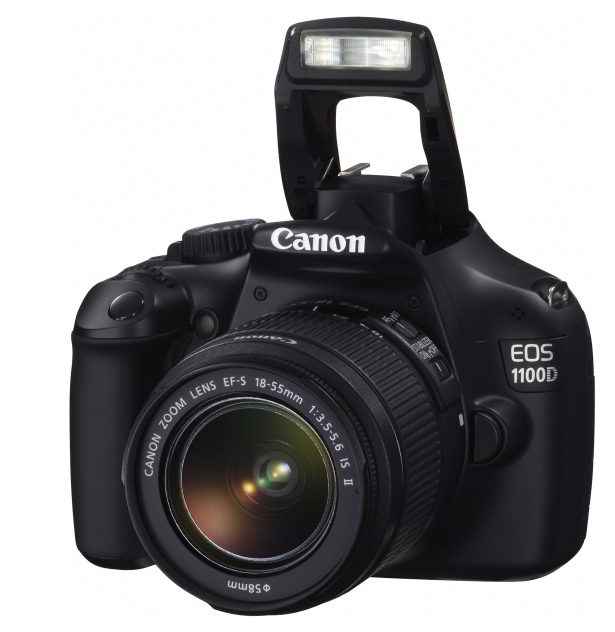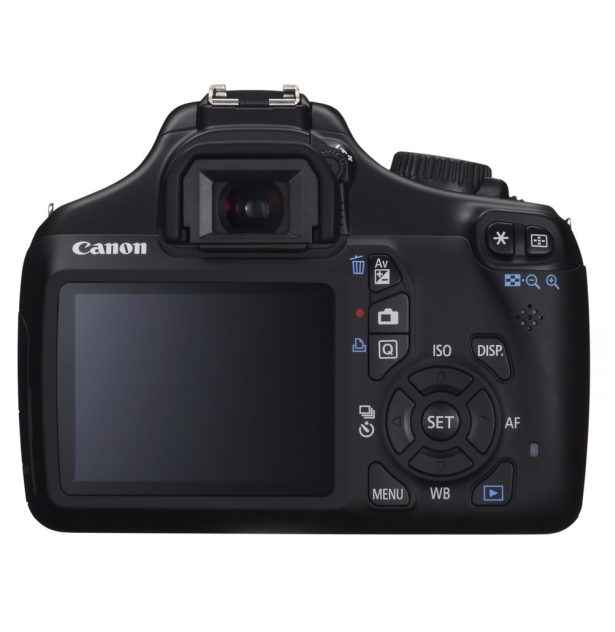As it stands, the 1100D is a good camera to buy for upgraders from a 1000D, or even Nikon shooters with a D60 who want to change over. If you are using a compact camera and looking to upgrade to a dSLR, the 1100D will expand your shooting possibilities, but remember that investing in lenses is a cost that you should consider, and the kit lens does not do the sensor justice.
But dSLRs aren’t meant to be updated every few months, and while Nikon obviously intended to make a dent in Canon sales with newer offerings. After all, we’re consumers who buy stuff, and then like to see it obsolete within 6 months, right? Planned obsolescence is evil…remember that.
Look and feel
We received the EOS 1100D for review around 3 weeks ago. When we first looked at it, we thought extra large compact. Gone are the rubber grips strategically placed to coincide with your palm and fingers – the 1100D has a smooth outer shell. Its nearest competitor, the Nikon D3100 has the semblance of rubber grips, but is a bit smaller. Actually, the 1100D is a far cry for those used to larger bodies, but then, few with a pro-grade body would pick up an entry-level dSLR as a backup body. Grips aside, the 1100D feels nice in hand, and is definitely a step up for people upgrading from a compact camera, or even an ultra zoom.
It’s got good heft, but is reasonably light at 450 grams for the body, including its battery, a 1500 mAh unit. Typical to its class, the 1100D doesn’t have the complex system of dedicated buttons and dials, but makes do with a single dial just behind the shutter button. The display is also smaller at 2.7-inches, and owing to the compact body, there are no buttons down the left side. Instead, the 1100D has a jumble of buttons on the right side, close to your palm grip. There’s no status LCD, and we didn’t expect one on an entry-level camera either.
The buttons on the 1100D take a bit getting used to for someone who is used larger, professional bodies. Still, once I got used to them, they’re pretty well laid out, and even better – they’re quite large. In fact, they feel very nice to press. Key travel is a little excessive, and this sometimes involves you doing a double take when a button is pressed but nothing happens because you didn’t press hard enough to register contact. Still, the large keys make it fairly intuitive to use, and the buttons are well labelled. Gone is the joypad, replaced by elongated buttons that have secondary functions as well as act as directional keys. A dedicated live view button is a nice plus, as is the “Q” button, for quick menus. Overall, while not the equivalent of a higher-end and costlier body, the 1100D is nice to use, and the buttons are pretty easy to get used to.
 |
 |
Features
[RELATED_ARTICLE]A new 12.2 megapixel CMOS sensor is just one of the highlights of the 1100D. Obviously many would have liked to see a larger megapixel count, but one must remember the 1100D is an entry-level body. Given that noise becomes increasingly difficult to contain with denser clusters of pixels, we feel this resolution is about right. The 1100D has an ISO range of 100 to 6400 – this is also more than enough for nearly every shooting condition. Moving on to the display, we really feel Canon was a bit skimpy with a 2.7 inch, 230000-dot unit, whereas the Nikon D3100 has a proper 930000 dot, 3 inch unit. Given the detailed sensor, you really should get a better display to preview shots. On a side note, the display has a nice neutral look.
The 1100D might not inherit the 7Ds sensor, but it gets the 63 zone metering system from its larger sibling. While hardly anybody found the earlier metering system inaccurate, we’ve accepted the fact that manufacturers will play the numbers game by upping features that do not necessarily need upping. However, from what we’ve seen of Canon dSLRs that feature this new metering system, it works pretty well, and is quite accurate.
On the software/interface front, nothing much has changed. Sure, it’s not broken, so don’t fix it, but we’d like the “Q” quick button system to become a little more visual. Nikon has taken the pictorial route with their entry level dSLRs, and on the D3100 and D5100, if you change basic settings for example ISO, you’ll get a small pictorial representation of the kind of scene you should be looking to capture at that setting. Most people familiar with photography will not need such tutoring, but it’s nice to have nonetheless.
The 1100D adds video shooting, something that is becoming a norm for dSLRs these days, although support for only 720p at 29.97 fps or 25 fps is present. The D3100 in comparison will do full 1080p, but at 24 fps. We feel Canon missed a trick by not including full HD support, but they probably wanted to build a bigger gap between this and the EOS 600D, that’s not to justify this omission, but to explain it. The EOS 1100D has a very nice battery – rated at 1500 mAh – Canon figures this battery will last for up to 700 shots.
Read the rest of our Canon 1100D review, with its performance, and our verdict, on the next page…
In the meanwhile, also check out our other, recent, dSLR reviews:
Nikon D3s – A killer professional body and the low-light champ [Review]
Nikon D7000 – An interesting middleman [Review]
Canon EOS 60D – The fence straddler [Review]
Canon EOS 7D – King of crops! [Review]
Canon EOS 1D Mark 4 – A quality crop, but full frames are cheaper [Review]
Performance
Long time users of the EOS 1000D testify to its good image quality, not as good as the better dSLRs, but definitely a step up from point-n-shoot cameras. One of the things we noticed right away is the fair amount of detail visible in the shots. The 1100D has an output that is similar to other Canon dSLRs in terms of colour tone, but unlike some of the other mid-range cameras, it seems to have a sharper output. For example, the Canon EOS 7D has a slightly softer output that hides noise, even as it starts to obscure finer detail. And this doesn’t mean the 7D isn’t sharp, it is just less so compared to higher-end Canon dSLRs. The 1100D seems to be characteristically more like the higher end dSLRs. This is probably on account of a weaker, (than the 7D anyways), low-pass filter.
[RELATED_ARTICLE]The base ISO output is very clean, without any sort of noise or grain. The 12.2 MP sensor resolves a fair amount of detail, but is still not as sharp as the professional range of Canon dSLRs. But this is their cheapest dSLR, and it is certainly good enough for budding dSLRs users who buy one to sport huge grins. In fact, we were impressed with the amount of detail visible at ISO 100/200 and 400 even when viewing 100% crops. Highlighting is good, but there is a bit of clipping noticeable, especially in our test around the paper clips – highlights blend, and some are overblown and look like blobs. There is great detail in the flowers we shot, and minute gradients in colour on the petals is very realistic, we couldn’t detect flaws, although larger sensors do resolve much more detail. The issue with lack of detailing that occurred on the 7D with red on red has been addressed.
So good, in fact, is the 1100D, that going from ISO 400 to ISO 800, there is no extra noise visible – the output remains clean, and it remains detailed. About the only difference we could spot, was the slight softening of output in regions not in the same focal plane as the point of focus. Also visible is a slight reduction in texture on the flowers, ISO 400 was better in this regard. Still on the whole, the output is very good, and unless you’re a purist, you’ll have no cause for complaint. ISO 1600 surprised us. Unless you are looking at shots taken at ISO 800 and 1600 side by side, there’s not a lot of difference and even then, the sensor on the 1100D holds up pretty well. There is a bit of noise visible now, but it’s quite pleasant, almost like film grain. Chroma noise is absent. There are a few odd coloured pixels visible in 100% crops, but this isn’t a big deal. Surprisingly, at ISO 1600, the output is sharper than at ISO 800. It’s almost as if noise suppression (and therefore sharpness reduction) has been turned off. We like this output – it is better to show realistic noise and preserve detail, than to have visible noise reduction applied and have a softer output. After all, it is easier to post process noise away than get details that aren’t visible to emerge.
At ISO 3200, there is a lot more visible noise in 100% crops and for the first time, some fine chroma noise is visible. The highlights also start to lose their punch, and become a bit more muted. The texture on the pear also loses a bit of detail. Still, when viewing anything smaller than a 100% crop, the output is still remarkably clean. Obviously, if you’re shooting in less than ideal studio lighting, you will notice much more noise, but in well-lit environs, the sensor holds up well.
At ISO 6400, the noise really begins to assert its presence and insinuate itself into every part of the image. The output doesn’t really get soft, it is just noise that starts to obscure finer details. The flowers when viewed at 100% look a bit snowy, and there is a slight loss of detail visible at even at a full-screen image size (1440×900 pixels). However, to be honest, this is only true if you know where to look, and at casual glance, the output is fine if you need lower resolution shots.
The 1100D focuses pretty fast when compared to the 1000D that would take just a hairsbreadth more time to lock on. It’s no 7D, and will hunt in many situations, but for the most it won’t let you down. We found that when AF does lock on, focus is very sharp – this body had no issue with back/front focusing.

Canon 1100D – ISO 1600
|

Canon 7D – ISO 1600
|

Nikon D7000 – ISO 1600
|
Our take
After nearly three years, the 1000D finally finds itself at the end of the road. A road that has garnered loads of support for Canon as well as favourably affecting their sales figures. The 1100D isn’t really chock full of features – we’d like a better focussing system, a slightly larger viewfinder, and perhaps rubber grips for a secure in-hand feel. However, for an entry-level dSLR it doesn’t do badly, and performs really well. The sensor is really its standout feature, remaining mostly clear and crisp till ISO 1600, outdoing the likes of the EOS 50D easily, heck its newer sensor even gives the Canon 7D Nikon D7000 a good run for their money at least in terms of presence of noise, if not sharpness and resolution. The price of Rs. 29,990 is great for the performance and includes an 18-55 kit lens. This latter piece of equipment is decent, but if it’s quality you are after, you’ll use something akin to the EF 24-105 f4 that we used to test this.
The EOS 1100D includes video shooting, but really Canon has cut corners with only support for 720p and not full HD. Dual SD card slots would also be great, but that wasn’t to be. So we see a camera that is definitely a step up from the model it replaces, although features have been engineered so as to give future headroom for an EOS 1200D (if the 1100Ds successor will be named thus). As it stands, the 1100D is a good camera to buy for upgraders from a 1000D, or even Nikon shooters with a D60 who want to change over. If you’re using a compact camera and looking to upgrade to a dSLR, the 1100D will expand your shooting possibilities, but remember that investing in lenses is a cost that you should consider, and the kit lens doesn’t do the sensor justice.
Specifications: Sensor: 12.2MP CMOS, APS-C size; focus points: 9 including 1 cross type; ISO Range: 100-6400; weight: 450 grams;
Also check out our other, recent, dSLR reviews:
Nikon D3s – A killer professional body and the low-light champ [Review]
Nikon D7000 – An interesting middleman [Review]
Canon EOS 60D – The fence straddler [Review]
Canon EOS 7D – King of crops! [Review]
Canon EOS 1D Mark 4 – A quality crop, but full frames are cheaper [Review]
|
Brand
|
Canon
|
|
Model
|
EOS 1100D
|
|
Price (Rupees)
|
29990
|
|
Specifications
|
|
|
Sensor resolution (MegaPixel)
|
12.2
|
|
Sensor type
|
CMOS
|
|
Sensor size (in mm)
|
22.2 x 14.7
|
|
Sensor area (in mm^2)
|
326.34
|
|
Viewfinder type
|
Optical Penta Mirror |
|
Minimum ISO speed
|
100
|
|
Maximum ISO speed
|
6400
|
|
Fastest Shutter Speed
|
1/4000 sec
|
|
Slowest Shutter Speed
|
30
|
|
Bulb Mode (Y / N)
|
Y
|
|
Number of focus points
|
9
|
|
Cross-type points (Y / N)
|
1
|
|
Custom White balance (Y / N)
|
Y
|
|
Built-in Flash (Y/N)
|
Y
|
|
Flash Range (in meters)
|
13
|
|
External Flash support (Y / N)
|
Y
|
|
AF Assist lamp (Y / N)
|
Y
|
|
Red-eye reduction (Y / N)
|
Y
|
|
Aperture Priority Mode (Y/N)
|
Y
|
|
Shutter Priority Mode (Y/N)
|
Y
|
|
Continuous Drive (frames per second) |
3
|
|
LCD Size
|
2.7
|
|
LCD Resolution (dots)
|
2,30,000
|
|
Status LCD on top (Y / N)
|
N
|
|
Image Formats supported
|
RAW, JPEG
|
|
HDMI out (Y / N)
|
Y
|
|
Video Mode (Y / N)
|
Y
|
|
Max Video capture resolution (in pixels)
|
1280 x 720 @ 29.97
|
|
Audio recording in Stereo / Mono
|
Mono
|
|
Battery Type (AA, Li-ion)
|
Li-ion
|
|
Battery Capacity (mAH)
|
1500 mAh
|
|
Format of memory card (CF, SD etc)
|
SD
|
|
Dual Card Slots (Y / N)
|
N
|
|
Integrated vertical grip (Y / N)
|
N
|
|
Body Dimensions (in mm)
|
129.9 x 99.7 x 77.9mm |
|
Weight, body only (in grams)
|
450
|
|
Lens mounts supported
|
Canon EF/EF-S
|
|
Image stabilisation built-in body (Y / N)
|
N
|
|
Build Quality (So 10)
|
|
|
Body
|
6
|
|
Buttons and dials
|
6
|
|
Bays / moving parts
|
7
|
|
LCD screen / status displays
|
7.25
|
|
Rubber flaps on ports
|
6.75
|
|
Ergonomics and usability (So 10)
|
|
|
Grip comfort and feel
|
6
|
|
Placement of buttons and dials
|
6.25
|
|
Feel of buttons and dials
|
6.5
|
|
Intuitiveness of menu system
|
7.25
|
|
Level of detail in menus
|
5.5
|
|
Performance (at ISO 100, 200)
|
|
|
Quality (dynamic range, highlighting)
|
7
|
|
Quality (sharpness, micro-details)
|
7
|
|
Back/Front focussing test (So 10)
|
7.5
|
|
Effectiveness of Image Stabilisation
|
5
|
|
High ISO tests (So 10)
|
|
|
ISO 400
|
8
|
|
ISO 800
|
7.75
|
|
ISO 1600
|
7
|
|
ISO 3200
|
6.75
|
|
ISO 6400
|
5.5
|
|
ISO 12800
|
0
|
|
Flash test (portrait)
|
7
|
|
Flash test (fill-scene)
|
7.25
|
|
Video Quality (720p)
|
7
|
|
Video Quality (1080p)
|
0
|
|
Audio Quality
|
6.75
|
